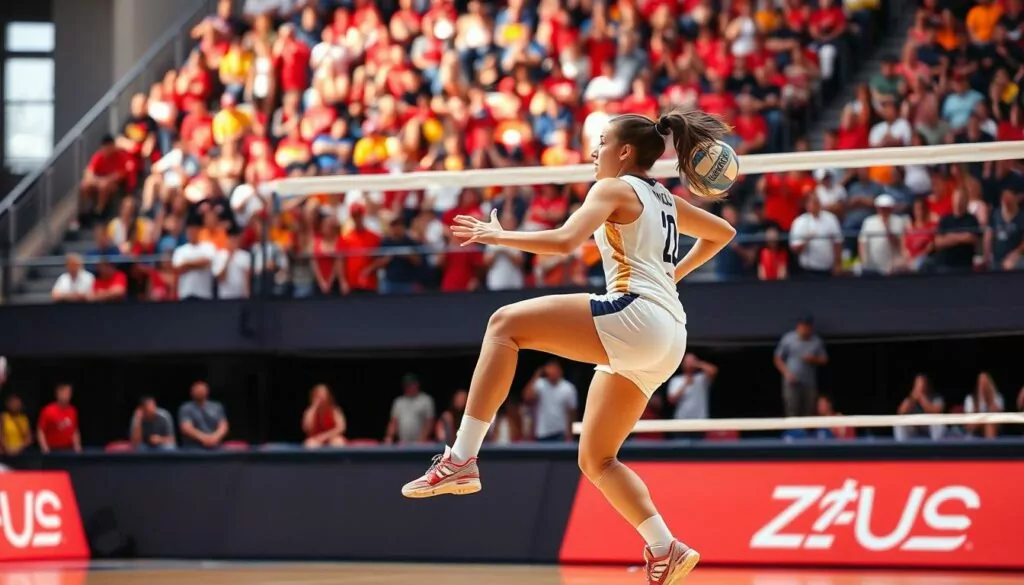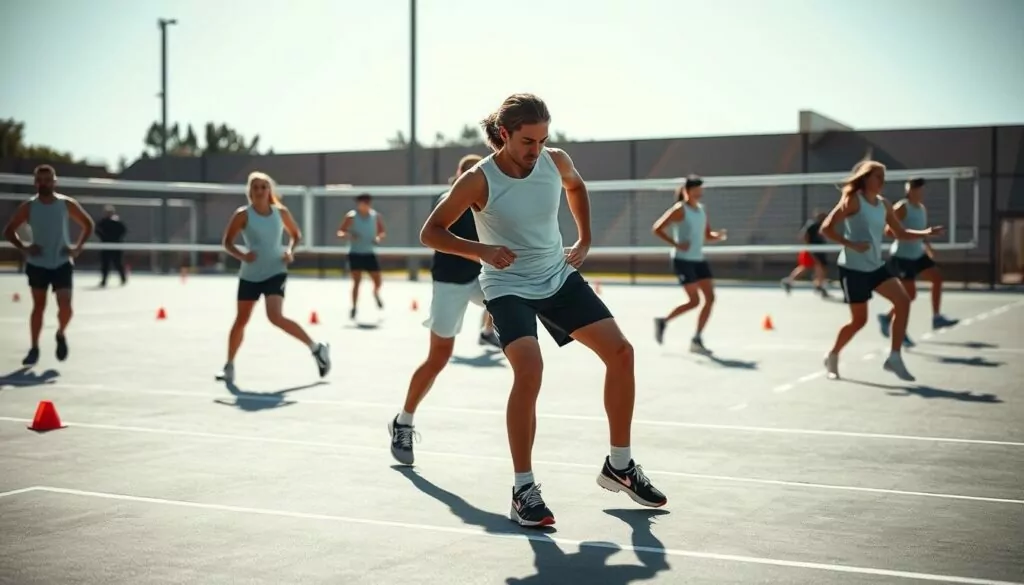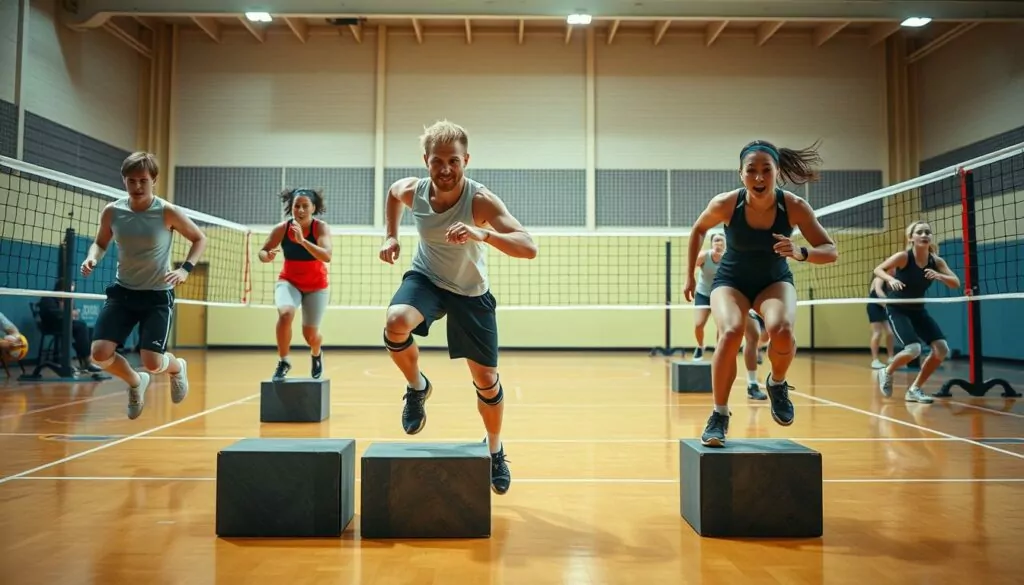I still remember the moment that sparked my passion for maximizing agility in volleyball. It was during a crucial match in college when our star libero pulled off an incredible save. She darted across the court, changing direction in a split second, and managed to keep a seemingly impossible ball in play. That display of agility not only won us the point but also the entire game. It was then I realized the power of quick, precise movements in volleyball.
Since that day, I’ve dedicated myself to mastering and teaching the art of agility on the court. Through years of experience and research, I’ve discovered that combining footwork drills with plyometric training is key to enhancing a player’s agility. In this guide, I’ll share my insights and proven techniques to help you elevate your game to new heights.
Key Takeaways
- Agility is crucial for success in volleyball
- Footwork drills improve court coverage and reaction time
- Plyometric training enhances explosive power and quick movements
- Core strength forms the foundation of agile movements
- Lateral movement training is essential for defensive plays
- Speed ladder workouts boost overall quickness on the court
Understanding Agility’s Role in Volleyball Success

Agility is a game-changer in volleyball. I’ve seen firsthand how quick movements can make or break a play. Let’s dive into the science and impact of agility on the court.
The Science Behind Quick Movement on the Court
Agility in volleyball relies on fast-twitch muscle fibers. These fibers fire rapidly, allowing players to change direction in a split second. Neuromuscular training enhances the brain-muscle connection, improving reaction times crucial for maximizing agility in volleyball.
How Agility Impacts Performance
Agile players dominate the court. They reach balls others can’t, making impossible saves look easy. Quickness drills boost defensive skills and attacking power. Speed and reaction drills sharpen a player’s ability to read the game, leading to better positioning and decision-making.
Key Components of Volleyball-Specific Agility
Volleyball agility isn’t just about speed. It’s a mix of balance, coordination, and power. Here’s a breakdown of crucial elements:
| Component | Description | Training Focus |
|---|---|---|
| Lateral Movement | Quick side-to-side steps | Shuffle drills, side lunges |
| Vertical Explosiveness | Jumping power and quickness | Box jumps, plyometrics |
| Directional Changes | Rapid 180-degree turns | T-drill, figure-8 runs |
| Reaction Time | Responding to visual cues | Ball reaction drills, partner exercises |
By focusing on these components, players can significantly improve their court presence and overall performance.
Essential Footwork Drills for Better Court Coverage

I’ve put together a set of footwork drills that will take your volleyball game to the next level. These exercises are designed to boost your speed, precision, and efficiency on the court. Let’s dive into some drills that will help you cover more ground and react faster during matches.
One of my favorite quickness drills is the “Box Drill.” Set up four cones in a square, about 10 feet apart. Start at one cone and sprint to the next, then shuffle to the third, backpedal to the fourth, and finish with a lateral slide back to the start. This drill works on all the movement patterns you’ll use in a game.
For lateral movement drills, try the “Zigzag Drill.” Place six cones in a zigzag pattern, each about 5 feet apart. Start at the first cone and shuffle quickly between them, touching each cone as you go. This improves your ability to change direction rapidly, crucial for defensive plays.
To enhance your footwork near the net, practice the “Net Shuffle.” Stand parallel to the net and take quick, small steps sideways for the length of the net. Then reverse direction. This drill helps with blocking and adjusting your position for attacking.
“Footwork is the foundation of great volleyball. Master these drills, and you’ll see a dramatic improvement in your court coverage and overall performance.”
Remember, consistency is key with these footwork drills. Incorporate them into your regular training routine, and you’ll soon notice improved agility and quickness on the volleyball court.
Maximizing Agility in Volleyball Through Plyometric Training

Plyometric training is a game-changer for volleyball players looking to boost their agility and explosiveness. I’ve seen firsthand how these dynamic exercises can transform an athlete’s performance on the court. Let’s dive into some key plyometric drills that will take your volleyball skills to the next level.
Box Jump Variations
Box jumps are a staple in plyometric training. Start with basic two-foot jumps onto a stable platform. As you progress, try single-leg jumps or lateral jumps. These variations challenge your balance and mimic the quick directional changes needed in volleyball.
Depth Jumps for Explosive Power
Depth jumps are intense but effective. Step off a raised platform and explode upward as soon as you touch the ground. This drill develops the reactive strength crucial for powerful spikes and blocks. Remember to land softly to protect your joints.
Multi-Directional Jumping Exercises
Volleyball demands agility in all directions. Incorporate multi-directional jumps into your routine. Try star jumps, where you leap to different points of an imaginary star on the ground. This improves your ability to quickly change direction during rallies.
Combine these plyometric exercises with speed and reaction drills for a well-rounded training program. Start with 2-3 sessions per week, focusing on quality over quantity. As your form and endurance improve, gradually increase the intensity and complexity of your jump training routine.
“Plyometrics have revolutionized my approach to volleyball training. The explosive power I’ve gained has made a noticeable difference in my game.”
Remember, proper form is crucial in plyometric training to prevent injuries and maximize benefits. Always warm up thoroughly and listen to your body. With consistent practice, you’ll soon see improvements in your agility, vertical leap, and overall court presence.
Core Strength: The Foundation of Agile Movement
Core strength is key to maximizing agility in volleyball. A strong core helps players move quickly, change directions, and maintain balance on the court. I’ll share some effective core strength exercises that can boost your performance.
Dynamic Core Exercises for Volleyball Players
Dynamic core exercises mimic the movements you’ll make during a game. Try these:
- Russian twists with a medicine ball
- Plank reaches
- Standing cable rotations
These exercises target your abs, obliques, and lower back, improving your overall stability and power on the court.
Stability Training Techniques
Stability training is crucial for maintaining balance during quick movements. Include these in your routine:
- Single-leg deadlifts
- Bosu ball squats
- Side planks with leg lifts
These exercises challenge your balance and strengthen the small stabilizer muscles that keep you steady during gameplay.
Core-to-Extremity Power Development
To generate power from your core to your limbs, try these exercises:
- Medicine ball slams
- Woodchoppers
- Kettlebell swings
These movements teach your body to transfer power from your core to your arms and legs, essential for powerful spikes and serves.
By incorporating these core strength exercises into your training, you’ll see improvements in your agility and overall performance on the volleyball court. Remember to pair these with quickness drills for the best results.
Speed Ladder Workouts for Enhanced Quickness
Speed ladder workouts are game-changers for volleyball players looking to boost their agility and quickness. I’ve seen firsthand how these drills can transform a player’s footwork and reaction time on the court.
Let’s dive into some effective agility ladder workouts that’ll take your game to the next level:
- High Knees: Run through the ladder, lifting your knees high with each step.
- Lateral Shuffles: Move sideways through the ladder, touching each square.
- In-and-Out: Step into each square with both feet, then out to the sides.
- Ickey Shuffle: A three-step pattern that challenges coordination.
- Hopscotch: Hop on one foot, then two feet, alternating as you progress.
These footwork drills not only improve your speed but also enhance your balance and coordination. Start with 3 sets of each exercise, performing them for 30 seconds with a 15-second rest between sets.
To maximize the benefits of these quickness drills, I recommend incorporating them into your training routine 2-3 times a week. As you progress, increase the speed and complexity of the patterns to keep challenging yourself.
| Drill | Focus Area | Repetitions |
|---|---|---|
| High Knees | Leg Speed | 3 x 30 seconds |
| Lateral Shuffles | Side-to-Side Movement | 3 x 30 seconds |
| In-and-Out | Footwork Precision | 3 x 30 seconds |
| Ickey Shuffle | Coordination | 3 x 30 seconds |
| Hopscotch | Balance and Rhythm | 3 x 30 seconds |
Remember, consistency is key when it comes to agility ladder workouts. With regular practice, you’ll notice significant improvements in your on-court movement and reaction time.
Lateral Movement Training: Essential Defensive Drills
Lateral movement drills are key to boosting your volleyball defense. I’ve seen players transform their game by mastering these skills. Let’s dive into some top-notch exercises that’ll have you moving like a pro on the court.
Shuffle Training Techniques
Shuffling is the bread and butter of volleyball defense. I start my players with basic side-to-side shuffles, gradually increasing speed. We mix it up with diagonal shuffles and figure-eight patterns. These drills build the quick feet needed for stellar court coverage.
Reactive Movement Patterns
Speed and reaction drills are crucial for maximizing agility in volleyball. I use partner drills where one player points left or right, and the other reacts instantly. We also practice with random ball tosses, forcing quick directional changes. These exercises sharpen your reflexes and decision-making.
Court Position Transitions
Smooth transitions between court positions can make or break your defense. I set up drills that mimic real game scenarios, like moving from the back row to the net for a block. We practice quick switches between defensive and offensive stances. By nailing these transitions, you’ll always be ready for the next play.
